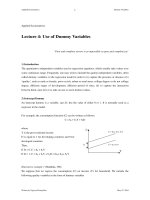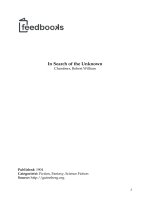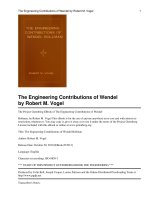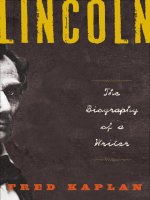EMERGENCE OF HINDUISM FROM docx
Bạn đang xem bản rút gọn của tài liệu. Xem và tải ngay bản đầy đủ của tài liệu tại đây (7.59 MB, 184 trang )
EMERGENCE OF
HINDUISM
FROM
CHRISTIANITY
M. M. NINAN
Copyright
Prof. M.M.Ninan
All rights reserved.
August, 2006
Published by
San Jose, CA 95124
EMERGENCE OF HINDUISM
FROM CHRISTIANITY
M. M. NINAN
CONTENTS
0 PREFACE 1
1 THE ACTS OF THOMAS 5
2
RELIGIONS OF INDIA WHEN THOMAS ENTERED
INDIA
25
3 THE CHRISTIAN CHURCHES OF THOMAS 34
4 THE THEOLOGICAL EVIDENCE 40
5 THE LINGUISTIC EVIDENCE
:
SANSKRIT 45
6 ARCHEOLOGICAL EVIDENCES 49
7 DOCUMENTARY EVIDENCES 58
8 CONCEPTUAL EVIDENCES 70
9
FIVE BASIC DOCTRINAL ASPECTS OF
SAIVISM
AND VAISHNAVISM
88
10
A
A
R
R
R
R
I
I
V
V
A
A
L
L
O
O
F
F
G
G
N
N
O
O
S
S
T
T
I
I
C
C
I
I
S
S
M
M
94
11 FORMATION OF HINDUISM
104
12 HINDUISM IN KERALA 112
13
KALABHRA INTERREGNUM – THE DARK AGES OF
SOUTH INDIA
121
14
THE FIRST VAISHNAVA CONQUEST OF KERALA
131
15
THE MYTH OF PRESTER JOHN
143
16
THE SECOND VAISHNAVITE CONQUEST- THE
PARASURAMA MYTH
149
17 KERALA – GOD’S OWN LAND 153
When St.Thomas came to the Kerala coast in India,
he entrusted the gospel of Jesus – the Word made
flesh - to four families to keep and to teach.
Sankarapuri was one of them
from which we trace our heritage.
Dedicated
Dedicated Dedicated
Dedicated
to my wife
Ponnamma
and
to my children
Premeela, Ronnie
Neil, Anna
Preethy, Charley
Ajit , Jenny.
and to their descendants
“
I am the LORD, I have called you in righteousness,
I have taken you by the hand and kept you; I have
given you as a covenant to the people, a light to the
nations.”
EMERGENCE OF HINDUISM FROM CHRISTIANITY
M. M. Ninan
0
PREFACE
I am very much aware that what I am presenting is something that
is diametrically opposite to most of the traditional understanding. I
was pleasantly surprised when I discovered that I am not the only
one that came to this conclusion. This realization led to the First
International Conference on Early Christianity in India in New York
last year, where this was the central theme of discussion. The
sequel to that comes in the Second International Conference on
Early Christianity in India at Chennai, India next year.
This book is an attempt to present the reasoning in simple terms for
lay men and for easy reading. Since it is not an academic study,
some rigor will be missing and references and links will be missed.
The major reasoning is given in the body of the text while details
and alternate views are given in boxes so that those who want to
skip them can do so.
This book will set before you facts based on objective scientific
researches in history, archaeology, architecture, linguistics, and
written documentations about the facts of Indian History during the
period immediately after the Mission of St.Thomas in India. While
in the ongoing research in sciences, and correlating the scientific
data with history there is always room for alternatives. However all
alternatives must be able to explain all known facts. There are
obvious immovable markers in history. This obvious markers are
EMERGENCE OF HINDUISM FROM CHRISTIANITY
M. M. Ninan
2
ignored or simply masked by arbitrary definitions and assertions,
which has little or no truth.
One of the ways in which truth is masked and perverted, is to mix it
with untruth and transmit it through the powerful use of myths,
legends and sheer repetition and exaggeration. These are
essentially the tools of memorization used widely in Education. As
generations go by the lies are transmitted as truth. In every
generation, this attempt to pervert truth goes on, and we have come
to a point where we no longer know what exactly happened in
history even a few centuries ago.
Here are a few statements which everyone has come across and
have come to accept as truth. These are statements taken directly
from the World Wide Web.
1. The Vedic religion is the oldest religion in the world, dating
back to at least 1.7 million years.
2. Hinduism is 50,000 years old
3.
The Vedic scriptures are the oldest known to
man, dating
back to at least 1.7 million years.
4. Sanskrit is at least 3,500 years old.
5. Rama lived over twenty thousand years ago.
The fact is that, none of these claims can, even remotely,
supported by any objective evidence. It is one thing to claim
big, and altogether different to substantiate with evidences.
I do make several claims which seem outrageous. But they
are all based on sound verifiable facts of history, archealogy,
architecture, linguistics and clear written documentations.
These conclusions are inevitable results of the evidences.
Myths and legends are interpreted in terms of these available
data. The following are essentially the facts:
1. Hinduism did not exist before the second century, A D.
2. Sanskrit did not exist before the second century AD,
EMERGENCE OF HINDUISM FROM CHRISTIANITY
M. M. Ninan
3
3. There were no “Hindu Temples” before the second century
AD.
4. The name Krishna did not even exist before the third
century AD.
5. Idols (Vigrahas) did not appear in India before the third
century AD and in Kerala until the eighth century AD.
6. St. Thomas, - Judas Thomas – one of the disciples of
Jesus known commonly as the doubting Thomas came down
to India and had a successful ministy all over India and China.
My conclusions from all these basic realities are:
1. Earliest forms of Hinduism was indeed Thomas Christianity
with Isa as the center of worship.
2. Gnostic infilteration from Syria, the syncretic forces of the
then existing religions of India (viz.
Vedism, Budhism, Jainism
and the local fertility cults) created the Gnostic religion of India.
Later the Theosophical Society from America and the Indian
Indpendence Movement gave impetus to redefine and form the
present day form of religion known as Hinduism.
Hinduism as it exists today has its origin from the Thomas Ministry
and it is simply the Gnostic form of Thomas Christianity. This
takeover of Historic Christianity by the Gnostics under the Persian
Gnostics occurred around the third century in the Inner India and
took much later (eighth century) in Kerala Coast. In Kerala
Christianity survived longer in power, just because of its constant
contact with the rest of the Christendom. After the third century the
two religions, Historic Christians and Gnostic Hinduism grew further
and further apart. The Hinduism of today is the result of a long
process of Gnostic growth as is repeated in the New Age
phenomena in America today.
These are inevitable conclusions of the historical realities.
My gratitudes are to the Institute of Asian Studies, Chennai, which
encouraged me, especially its director Dr. John Samuel. I must
mention six names whose research stands as firm grounds on
EMERGENCE OF HINDUISM FROM CHRISTIANITY
M. M. Ninan
4
which I could build: Prof. M.Witzel of Cambridge University, Dr.
Alexander Harris (on Sanskrit), Dr. Deva Kala, (Savism
&Vaishnavism) Dr. Deva Nayakam, Prof. George Menacheri
(Kerala Christians) and my cousin brother Late Dr. T. V. Phillip. I
am indebted to them.
M.M.Ninan
San Jose CA
July 2006
EMERGENCE OF HINDUISM FROM CHRISTIANITY
M. M. Ninan
5
1
THE ACTS OF THOMAS
On the mount of Olive Jesus gave his disciples a commission,
which was to go into the entire world and to preach the gospel. The
Acts of the Apostles starts from there. However, the rest of the
Bible speaks mostly about Paul and Peter.
What happened to the other disciples?
We know that they went throughout the rest of the known world of
that time, but we do not have any definite record of their activities.
Their evangelization certainly must have been as fruitful as the
ministry of Peter and Paul. The Bible, as we have, contains only
EMERGENCE OF HINDUISM FROM CHRISTIANITY
M. M. Ninan
6
Acts of Thomas
AD 200-222
By
Bardesan
the Syrian Philosopher – Poet
the first phase of the expansion of The Way. (I use the word “Way”
because that was how it was known initially.) The New Testament
then describe how the Way expanded into Jerusalem, Samaria and
then into the Greco-Roman Culture since these were areas close to
the origin and were easily heard and known. Other Apostles had a
difficult time, since their journey took them into the uttermost parts
of the world, and no reporters went with them.
As such, we will have to look elsewhere for the Acts of other
Apostles and the logical place to look for them is in the areas where
they labored. In most cases, we do not really have a complete
account of their activities in documentation. Writing was a skill
unknown to common man in those days, and so the history of these
churches were never put in writing during the period of their
activities. It sometimes took several centuries of delay before they
were put in writing. Because of the lack of documentation, in olden
days, the history was transmitted orally in the form of stories,
legends, ballads, and myths. Moses who was skilled in the art of
writing trained in Egypt knew that the best way of transmission of
history was through ballads and songs. (“Deu. 31:22 So Moses
wrote this song the same day, and taught it to the people of Israel.”)
These are less reliable than documentations, but then these were
the next best thing possible. Because of the distortions and
embellishments that are necessary part of these literary forms,
these forms of transmission are unreliable and must be treated with
care.
Available Extra Biblical Sources.
Fortunately, in the
case of Thomas,
we have a written
record in the “Acts
of Thomas.” This
was written around
200 AD – over a
century after the
fact. The Poet
EMERGENCE OF HINDUISM FROM CHRISTIANITY
M. M. Ninan
7
Philosopher Bardesan of Syria. (155-223 AD) is considered to be
the author of this work.
Bardesanes was born in 154 CE, became a Christian c. 180 CE, and
died in 222/223 CE.
Bar-Daisan (Catholic Encyclopedia)
At the age of twenty-five he happened to hear the homilies of Hystaspes,
the Bishop of Edessa; he received instruction, was baptized, and even
admitted to the dioconate or the priesthood. … when Abgar IX, the friend
of his youth, ascended the throne (179) he took his place at court.
His acceptance of Christianity was perfectly sincere; nor do later stories,
that he left the Catholic Church and joined the Valentinian Gnostics out of
disappointed ambition, deserve much credit. His royal friend became the
first Christian king; and both king and philosopher labored to create the
first Christian State. Bardesanes showed great literary activity against
Marcion and Valentinus, the Gnostics of the day. But unfortunately, with
the zeal of a convert anxious to use his previous acquirements in the
service of the newly found truth, Bardesanes mixed his Babylonian
pseudo-astronomy with Christian dogma and thus originated a Christian
sect, which was vigorously combated by St. Ephrem.
Eusebius of Caesarea writes of Bardesanes
In the same reign, as heresies were abounding in the region between the
rivers, a certain Bardesanes, a most able man and a most skillful disputant
in the Syriac tongue, having composed dialogues against Marcion's
followers and against certain others who were authors of various opinions,
committed them to writing in his own language, together with many other
works. His pupils, of whom he had very many (for he was a powerful
defender of the faith), translated these productions from the Syriac into
Greek.
Among them there is also his most able dialogue On Fate, addressed to
Antoninus, and other works which they say he wrote on occasion of the
persecution which arose at that time. He indeed was at first a follower of
Valentinus, but afterward, having rejected his teaching and having refuted
EMERGENCE OF HINDUISM FROM CHRISTIANITY
M. M. Ninan
8
most of his fictions, he fancied that he had come over to the more correct
opinion. Nevertheless he did not entirely wash off the filth of the old
heresy. About this time also Soter, bishop of the Church of Rome,
departed this life.
J. Quasten writes (Patrology, vol. 1, pp. 263-264):
While all other writings perished, the dialogue Concerning Fate or Book of
the Laws of the Countries, which Eusebius mentions, survived in its
original Syriac. The author, however, is not Bardesanes but his disciple
Philip, although Bardesanes is the chief speaker in the dialogue, who
answers the questions and problems of his followers regarding the
characters of men and the position of the stars. According to Ephrem the
Syrian Bardesanes is the creator of Syrian hymnody, because he
composed one hundred and fifty hymns in order to spread his doctrine. His
success was so tremendous that Ephrem in the second half of the fourth
century had to combat this sect of Bardesanes by composing hymns
himself. Some scholars were of the opinion that the beautiful poem, The
Hymn of the Soul, in the apocryphal Acts of Thomas (cf. above, page 139)
was composed by Bardesanes. But this remains very doubtful, especially
since the contents of this famous hymn do not show any sign of
Bardesanian Gnosis. The Arab Ibn Abi Jakub in his list of sciences entitled
Fihrist from the end of the tenth century attributes to Bardesanes three
other writings, of which one dealt with Light and Darkness, a second with
The Spiritual Nature of Truth, and a third with The Movable and the
Immovable.
Fragments and copies of this work is available in Syriac (or
Aramaic), Coptic (or Ethiopic) and Latin. Translations are also
available freely over the internet. Bardesanes has traveled widely
in many different countries including India especially in the South
Indian regions where Christianity was the major religion of the
period. Since this is a story in the form of poetry, it is heavily
embellished with exaggerations, complete with talking Serpents and
Dragons. These were normal poetic forms of the period. However,
the historical settings are properly set and the events and persons
are true. At any rate, we do not have anything else to go by except
the legends and ballads that are handed down through generations
in Kerala. These concur with the Acts of Thomas Stories in
EMERGENCE OF HINDUISM FROM CHRISTIANITY
M. M. Ninan
9
historical and geographic details. Considering the situations
connected with other Apostles, this is very comfortable.
We do have several ballads in Malayalam, which are claimed to
have been handed down through generations but were not written
down until around of the sixteenth century or even later. These
traditions are contained in the following sources:
1 The Song of the Deacon – the Chapter on Thomas
known to us as “Rambaan Pattu – Thoma Parvam”
Rambaan (Deacon) Thomas of Malayakal family was one of the first
Deacons ordained by St, Thomas around AD 62. This was during
Thomas’s second visit to Kerala. Rambaan Thomas is said to have
compiled this song and taught it while he was alive. This oral
tradition was handed down as a folk song through generations.
This tradition of transferring history through songs is an age-old
method. Finally, in the 402
nd
generation of the first Rambaan
Thomas, another Rambaan Thomas of that family, committed it in
Indian traditions in dramatized Stories,
Ballads and Songs:
1. The song of Deacon
2. The Dramas of the Way
3. Songs of the Sons of the Great King
4. Ballads sung by tribals
5. Chavittu Nadakam – Tap Drama
EMERGENCE OF HINDUISM FROM CHRISTIANITY
M. M. Ninan
10
writing. That was in AD 1601. This therefore forms one of our
sources. The historical contexts in these songs agree with other
evidences and sources including the Acts of Thomas of AD 222.
Summary of Rambaan Paattu
Thomas the Apostle coming from Arabia, landed in Maliankara
(Maliankara is another name for present day Kerala region) in the
year AD 50 in the month of December /January. After a short
stay there he proceeded to Mailapuram (Mylapore) and from
there went to China. Coming back to Mailapuram port he sailed
to Maliankara being invited by the King of Thiruvanchikulam
(modern Cranganore), and founded seven churches there: in
Cranganore (where he arrived in AD 51 and baptized the King,
3000 pagans and 40 Jews), in Kollam, Chayal, Niranam, (to
which place the cross was transferred from the infidel village of
Trikpaleswaram), Kokkamangalam, Kottakayal (Parur) and
Palayur. (These are the seven churches well known in tradition).
In AD 59 in the month of September/October he was called back
to Mailapuram by King Cheran, who imprisoned him. …But the
king’s brother died at that time and was brought back to life
and Thomas was set free and the king along with 700
received baptism.
After a stay of two and a half years in Mailapuram, the Apostle
returned to Malabar via Malyattur and visited the old places:
Cranganore, Kottakayal, staying in each place for a year and
conferring on the faithful the sacrament of confirmation.
In Chayal, the Apostle took leave of the Christians, telling them
that they would not see him again.
Then in the year AD 69, he departed from there to the land of the
Tamils. At this point, the poem enumerates the miracles
performed by the Apostle: he brought back to life 19 dead, drove
the devil out of 260, etc
EMERGENCE OF HINDUISM FROM CHRISTIANITY
M. M. Ninan
11
In all he converted 17750 persons, of whom 6850 were Brahmins,
2800 Kshatriyas, 3750 Vaisyas and 4250 Sudras (These are the
various castes in India) Kepa and Paul are said to have been
consecrated bishops. Kepa belonged to the Cranganore royal
family and he was set over Kerala. He took part in the burial of the
Apostle.
Back in Milapuram in the year AD 72 on the 3rd day of
Karkadakam (July), on the way to the Little Mount, he was pierced
with a lance
(The summary is adapted from Mundadan : History of Christianity,
I, p.30-32 as given by Prof. George Menacheri).
2. The Morality Plays of the Christians. - The Drama of
the Way known in Malayalam as “Margam Kali”
The second source is the many folk dramas performed year after
year in churches through out Kerala. These are essentially morality
plays that are intended to instruct and to create a sense of history.
They were simple and direct presentations with intent to convey the
basic roots of the Malabar Churches.
Originally, the Dance of the Way was performed by men. In
modern times, it is performed by women.
EMERGENCE OF HINDUISM FROM CHRISTIANITY
M. M. Ninan
12
3. The Songs of the Sons of the Great Kings : known in
Malayalam as Maapilla Paattu.
There is still another set of ballads sung by Christians who were in
early years were called Maha Pillai (Great Sons – short as Mapilla)
or Princes. The origin of this name is of great interest and will be
taken up later in the History of Kerala Christians. These songs
were sung in groups in celebrations of the churches.
4. Songs on Stringed Instrument - Veeradian Pattu –
Villadichan Pattu
Strangely enough there is another series of ballads that comes
through a non-Christian tribal group which are sung in
accompaniment of stringed instrument consisting simply of a bow
strung with tight string called Villu.
All these were at least partially or fully documented with the
encouragement of Portuguese Missions who arrived in Kerala by
the 1600s.
Kerala Center in the US Celebrates India Independence Day &
Onam 2003, when this Villadichan Pattu was presented.
EMERGENCE OF HINDUISM FROM CHRISTIANITY
M. M. Ninan
13
5. Chavittu Nadakam : Tap Drama
Chavittu Nadakam is a folklore dance drama art practiced by
Christians in some parts of Kerala state of south India. These were
introduced by the Portugese in the 16
th
century following the
Kathakali tradition in the temple art. These are modifications of the
morality plays of Europe.
The main characters wear broached dress, headdress and crowns.
The soldiers have hats with quills. The background music is
supported by bells and drums. The stories are mostly related to
Christian history and Biblical stories. To emphasize the point, on
occassions the actors tap on the floor in rhythm. Hence it came to
be known as Tap Drama. It is very similar to what the Tap Dancers
do these days.
The Malabar (Kerala) and Indian traditions are referred to by
the early Church Fathers all through the history of the
church. Among them are the following references:
Clement of Alexandria 3
rd
C AD ( 235)
Doctrine of the Apostles 3rd C AD Syria
Oriegen 3rd (185-254 AD) quoted in Eusebius Alexandria
Eusebius (early 4th cent.) Caesarea
St. Jerome (342-420 A.D.) about the mission of Pantaenus,
to India .
St. Ephrem (306-373 A.D.),
St. Gregory of Nazianze (324-390 A.D.),
St. Ambrose (333-397 A.D.),
St. Jerome, St. Gregory of Tours (6th cent.)
Isidore of Seville (7th cent.)
From these traditions, we can roughly recreate the basic story, the
route taken by Thomas and the areas of his labor. We should not
EMERGENCE OF HINDUISM FROM CHRISTIANITY
M. M. Ninan
14
insist on accuracy in dates, maps, and routes, because the
calendars were only local and are difficult to transfer into our
present AD scale; and maps were not really in existence at that
time.
Travels of Thomas
According to all these traditions, Thomas traveled from Palestine
along the Spice route with a merchant called Habban (Habban in
Acts of Thomas, Apanna in some other traditions). This was to be
expected because the Port of Muziris (Muchiri – the three-lipped
Port) in the Malabar Coast had been a major commercial center of
that period, trading in the exotic spices like Pepper and Ginger.
These spices were in great demand in the Roman territories; and
Rome did not spare any effort to make these routes safe and fast.
After the discovery of Monsoon by the Roman seafarers, this travel
took less than forty days. Ptolemy's mid-second century map of
the world and the third century Tabula Peutingeriana or Peutinger
Table gives us a lot of insight. There were three possible entry
points into India. The first one was into Indus River mouth
(Barbarikor) in Punjab with direct entry to Taxila by River route.
The second one is (Barygaza) near Bombay (Mumbai) in the
Kalyan area, and the third into Kerala with the famous Muziris as
the main port, near present day Cochin Harbor. The Kerala
traditions claim that Thomas landed in Kerala and then moved on to
Taxila. There are some scholars who differ and think that the
Apostle landed in Taxila first and then came down to Kerala when
the Indo-Parthian Kingdom of Taxila was destroyed.
This route took Apostle Thomas and Habban through Yemen
where, Thomas established a church in Yemen that flourished for 6
centuries. It was destroyed around 600 AD at the onslaught of
Islam. I make mention of this here simply because I have been
privileged to be part of the Christian Church which came into
existence in Yemen after 1200 years as its first Moderator.
During his first week of stay in the Malabar Coast in the present
day Kerala, he established one church among the Jewish
community in that area. Then he traveled probably along the west
coast by land or by sea route to the country of King Gondaphores
EMERGENCE OF HINDUISM FROM CHRISTIANITY
M. M. Ninan
15
whose capital was in Taxila. TAxils is in the region of Punjab, in
modern Pakistan. Taxila (Taksha sila) was an Indo-Parthian
Kingdom at that time and Habban was taking Thomas to build a
palace for Gondaphores, the King of Taxila.
TAXILA
The city was called Takshaçila, which may be interpreted as
'prince of the serpent tribe'; in Pâli it was known as
Takkasilâ; the Greeks knew the town as Taxila, which the
Romans rendered as Taxilla; the Chinese called it Chu-ch'a-
shi-lo. The ruins are some 30 kilometers northwest of
modern Islamabad.
From the various versions of the stories, we cannot really establish
whether Habban took Thomas directly to Taxila or whether he
landed in Kerala first and then took the coastal route to Taxila. If
the events of Taxila took place before his South Indian Ministry
Thomas must have landed around AD 48 there. Later when the
Kingdom of Gondaphorus was destroyed, he took the sea route and
came down to Kerala. Regardless of the actual sequence of
events, Thomas landed in Kerala by AD 52.
Andrapolis and Habban
Acts of Thomas mentions a city called Andrapolis where they
landed before proceeding to Taxila the capital of Gondaphores.
(The name Taxila is not mentioned there) Historians differ as to the
exact location of Andrapolis, whether it was within India proper or a
nearby place. In the story it is said that from Andrapolis, Abban and
Thomas left for India. According to Warmington, Andrapolis was
the capital of the Andhra Kingdom in Deccan and was in India.
Habban probably is a corruption of popular Andhra name
“Appanna”
EMERGENCE OF HINDUISM FROM CHRISTIANITY
M. M. Ninan
16
The Commercial Routes of First Century
Other Views on the route of Thomas
“Only in North West”
“On the basis of the Acts of Thomas, there are historians who
argue that Thomas went only to the north west and they deny the
south Indian tradition.
“Only in the South”
Then there are others, who deny the Acts of Thomas as a reliable
historical source and accept only the south Indian tradition. They
point out that we do not possess any concrete evidence for the
early preaching of the Gospel in northwest India as we have for
south India. They say that the south Indian claim to apostolate is
supported by the fact that there is the community of St. Thomas
Christians with their living tradition and the tomb of St. Thomas
which is claimed to be that of the Apostle Thomas.
EMERGENCE OF HINDUISM FROM CHRISTIANITY
M. M. Ninan
17
Both South and North
“There is a third group who argue for both places. Bishop Medlycott,
H. Heras, J.N. Farquhar and S.H. Moffett are some of them.
Medlycott thinks of two separate journeys, one from Palestine
through Mesopotamia and Persia by land to north west India, the
other, after a return to Palestine, via Egypt and Ethiopia and
Socotra and thence across the Arabian Sea to Malabar. J.N.
Farquhar thinks of one journey in the East. He says that St. Thomas
first went to north western India travelling by sea and up the river
Indus, but had to leave because of the Kushan invasions, which
eventually wiped out the Christians of that region so that no trace
remained. Then he left India by sea, landed in Socotra and spent
some time there during which he made converts; and afterwards he
sailed for India again and came to Malabar, from where in due
course he crossed over to the east coast. He mentions that Thomas
even went to Burma, and after returning to India he was martyred at
Mylapore.”
East of the Euphrates: Early Christianity in Asia
by T.V. Philip
EMERGENCE OF HINDUISM FROM CHRISTIANITY
M. M. Ninan
18
Route of St.Thomas from Palestine to Malabar Coast through
Yemen along the Spice route. The most probable route according to
Kerala Traditions.
Traditional site where St. Thomas landed - Cranganore
(Kodungallur) in Malabar Coast -in 52 AD
EMERGENCE OF HINDUISM FROM CHRISTIANITY
M. M. Ninan
19
. Here he preached to a Jewish community who accepted mesia
and their synagogue became a Christian church.
The route of Thomas must have been along the west coast since
we have a Christian community near Bombay, which claims its
descent from Thomas. Thus having reached Taxila and converting
the King he traveled as far as China. From there he entered India
crossing the Himalayas and reached the Ganges plains and then
onto Central India.
The Church in Cranganuur – near Muziris
We have strong documentations, showing the existence of a
Christian community in the area around the river Kaveri in central
India. From there he traveled south into Madras and Kerala
reaching Kerala a second time around 62 AD. According to Kerala
traditions, he established eight churches. The names and places of
these churches are known even today as the Thomas Christian
cherishes their heritage.
EMERGENCE OF HINDUISM FROM CHRISTIANITY
M. M. Ninan
20
One of the main problems in accepting the stories connected with
Thomas were the lack of any information regarding a King called
Gondaphores (Gondophernes). However in 1854 a large collection
of coins were unearthed showing clearly the existence of the
Kingdom and he even had a brother called Gad as given in the
stories. An epigraphic stone in a nearby Buddhist community
center also corroborates this conclusion. We now know that about
the year 46 A.D., a king named Gondophernes or Guduphara was
reigning over that part of Asia south of Himalayas. This region is
now in the area known as Afghanistan, Baluchistan, the Punjab,
and Sind, a part of Pakistan. From the Takht-i-Bahi inscription, we
can deduce that King Gundaphara probably began to reign around
20 A.D. and reigned probably until 54 AD. The exact dates are
difficult to establish. I am keeping the traditional date of AD 52 for
the landing of Thomas. There are reasons for believing that the
kingdom of “Mazdai” as mentioned in the “Acts of Thomas” may
well be an Iranian attempt in pronouncing an Indian name. It will
probably represent a certain King Vasudeva of Mathura, a
successor of Kanishka.
Ruins of Taxila









